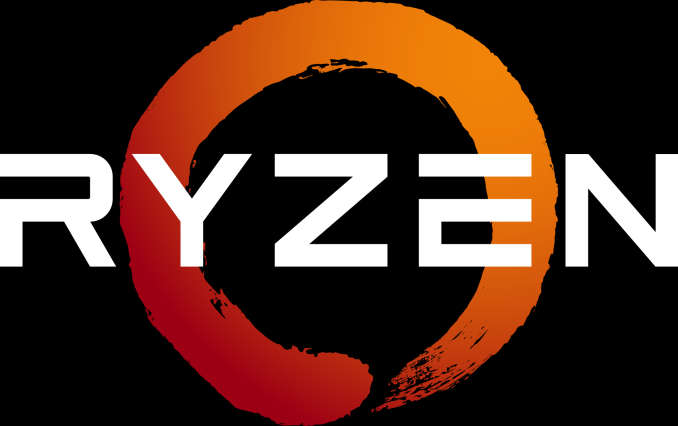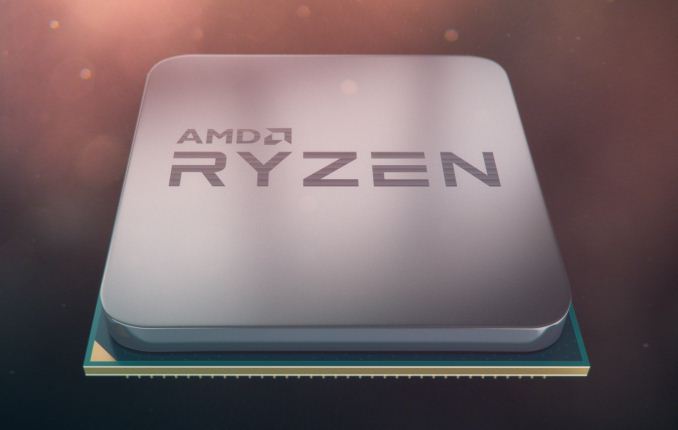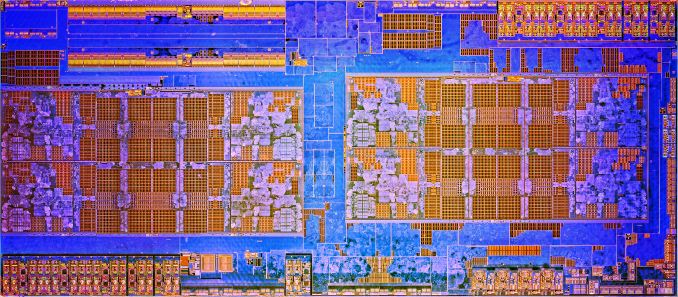AMD Launches Ryzen: 52% More IPC, Eight Cores for Under $330, Pre-order Today, On Sale March 2nd
by Ian Cutress on February 22, 2017 9:00 AM EST
The biggest x86 launch for AMD in five years is today: Ryzen is here. As always before a major launch, AMD gives a ‘Tech Day’ for relevant press and analysts, and through this event AMD’s CEO, Dr. Lisa Su lifted the lid on one of the most anticipated products in the semiconductor industry. AMD knows how to control the level of enthusiasm for its fans, and today is the end result, with processors going on pre-order from major retailers today at 1pm EST, ready for a general hard launch on March 2nd.
In a similar vein to launches of recent smartphones, AMD is doing a staggered announcement/launch with the products on their new microarchitecture. Where Samsung/Apple might give all the details for a product a few weeks before it’s available to buy, today on February 22nd marks the day where AMD is giving consumers information about Ryzen, and specifically the Ryzen 7 family of eight-core products. All the information today is from AMD, and AMD’s internal testing, and pre-orders also start from today for users ready to put down their money for a launch day part. Reviews of the CPUs, as well as when the CPUs will ship to customers, is on March 2nd. This also happens to be right in the middle of two annual shows, Game Developer Conference (GDC) and Mobile World Congress (MWC), making the time between receiving pre-launch samples and being able to provide independent verification of AMD’s performance claims relatively frantic. We’ll do our best!
The Ryzen Family
With a new processor launch, naming the parts and positioning them within the market is critical. So with Ryzen, the processor stack will be split into three based on performance and price: Ryzen 7 at the high end, Ryzen 5 in the middle, and Ryzen 3 for more price-conscious consumers. Both Ryzen 5 and Ryzen 3 are set to be launched later, and Ryzen 7 is the first portion of the family to be released.
Ryzen 7 will have three CPUs to start, all having eight cores and supporting simultaneous multi-threading:
- Ryzen 7 1800X: 8C/16T, 3.6 GHz base, 4.0 GHz turbo, 95W, $499
- Ryzen 7 1700X: 8C/16T, 3.4 GHz base, 3.8 GHz turbo, 95W, $399
- Ryzen 7 1700: 8C/16T, 3.0 GHz base, 3.7 GHz turbo, $329
Ryzen 7 1800X will be the high-end part, featuring a base clock of 3.6 GHz and a turbo of 4.0 GHz, within a TDP of 95W, and for $499. Next to this is Ryzen 7 1700X, launching at $399, with a base/turbo of 3.4/3.8 GHz. The final part for the launch is the Ryzen 7 1700, providing eight cores and sixteen threads for $329 at 3.0/3.7 GHz frequencies.
Processors will initially be available for pre-order from 185 retailers and OEMs worldwide, either as individual parts or pre-built systems.
What, not 40% IPC? 52% IPC??
Enthusiasts and analysts use the term IPC, or ‘Instructions Per Clock’, as a measure of how much the underlying microarchitecture improves from generation to generation. Two decades ago, a good design on a smaller node could net a healthy double-digit gain, whereas in recent years 5-10% gain has become the norm. When AMD initially announced that the new Zen microarchitecture they were developing was aiming for a 40% IPC gain, despite the low IPC they were starting from, users remained skeptical. AMD rehired Jim Keller to work alongside long-term AMD architect Mike Clark and produce a team with several goals in mind: high-performance x86, simultaneous multithreading, and a product to be relevant in the computing, PC, server and mobile space again. So despite this, 40% IPC always seemed a somewhat lofty goal, because Bulldozer was so underwhelming, and despite this low starting point. For the Ryzen launch today, AMD is stating that the final result of that goal is a 52% gain in IPC.
This is something we will need to test in due course!
The Ryzen Silicon, and the Future
AMD pointed out that the new 8-core silicon design runs 4.8 billion transistors and features 200m of wiring. Through previous announcements we’ve examined parts of the microarchitecture including cache sizes, threading, front-end/back-end design, and so on.
AMD Zen Microarchiture Part 2: Extracting Instruction-Level Parallelism
AMD Gives More Zen Details: Ryzen, 3.4 GHz+, NVMe, Neural Net Prediction, & 25 MHz Boost Steps
AMD’s CEO was keen to point out that this is a from-scratch design for AMD, using the knowledge gained from features developed for previous products but ultimately under the hood it looks like ‘a typical x86 high-performance core’, with AMD-specific features and tweaks. We were told that AMD’s roadmap extends into the multi-year range, so while the focus for 2017 will be on this family of products, back at HQ the next two generations are in various stages of development.
BENCHMARKS PLEASE
So despite the 82+ motherboards going to be available, 19 initial PC system builders moving into 200+ through the first half of 2017, the big question on everyone’s lips is how exactly does it perform?
Well, AMD gave us the following numbers:
AMD's benchmarks showed that the top Ryzen 7 1800X, compared to the 8-core Intel Core i7-6900K, both at out-of-the-box frequencies, gives an identical score on the single threaded test and a +9% in the multi-threaded test. AMD put this down to the way their multi-threading works over the Intel design. Also, the fact that the 1800X is half of the price of the i7-6900K.
In a similar vein, again with the Cinebench 15 multi-threaded test, the Ryzen 7 1700X scores over and above the Core i7-6800K (its price competition) and higher than the Core i7-6900K which costs 2.5 times as much.
We’ll tell you what our benchmarks say, with official retail processors. But you will have to wait until March 2nd. Sorry.





















386 Comments
View All Comments
random2 - Wednesday, February 22, 2017 - link
Takes you a while to catch on does it? The advantage became clear with Conroe. :)Do love the fact AMD appears to be back in the game.
redraider89 - Monday, February 27, 2017 - link
Don't discount the shady practices that muc. The reason they gained technological superiority is because of the flush of cash the got from those shady deals, which they poured into research and development while restricting AMD's cash to pour into research and development. Instead of research and development, it forced AMD into survival mode, not grow and expand mode. So they ARE ahead a large part of because of shady business practices.redraider89 - Monday, February 27, 2017 - link
CORRECTED typos: Don't discount the shady practices that *much*. The large part of the reason they gained technological superiority is because of the flush of cash *they* got from those shady deals, which they poured into research and development while restricting AMD's cash to pour into research and development. Instead of research and development, it forced AMD into survival mode, not grow and expand mode. So they ARE ahead a large part because of shady business practices.
mapesdhs - Tuesday, February 28, 2017 - link
("may have"??)Hmm, superior technology eh... does that include deliberately heat-crippling IB with poor thermal transfer material? (check the YT delidding results and tech site articles, up to 35C load temp drop) How about the two locked-out cores of the 3930K, because AMD couldn't even compete with Intel's 4-core? Or the lack of USB3 or other improvements with X79? Or the lack of more PCIe lanes for multiple generations? Or the crippling of PCIe down to 28 lanes with the 5820K onwards? (the 4-core 4820K can be faster for multi-GPU since it has 40 lanes, higher oc with its greater per-core thermal limit, and no restrictions on GPU vs. storage allocation) Or how about the insane price hikes? The list goes on and on. There was no competition, so Intel sat on its butt for 5 years. Intel had the better tech back in the days of SB, but their monopoly has stagnated the market, as always happens when there is no competition. Year after year with little to encourage users to upgrade, yet sites kept reporting declining PC sales (well duh).
Intel made the 2500K, etc. too good (from their point of view), then spent the next 5 years kicking customers in the face. They could have released an 8-core CPU back then, because in reality that's what the 3930K is; they didn't because there was no need to, the 1100T couldn't even take on the 2600K (*), never mind the 6 allowed cores of the 3930K (much of the time 1100T is slower than the 2500K). Not seeing the implication of "superior technology" when this situation meant the market had to wait a crazy amount of time for a consumer 8-core, and when it finally came out the cost was utterly through the roof (even as I type it's still a whopping 1100 UKP on Scan UK, which was nuts long before we knew how Ryzen was going to be priced).
If Intel ends up in a pickle as a result of a disruptive Ryzen launch, it's nothing less than Intel deserves. They had a lead back with SB to which they were justly entitled, but ever since then it's been one snoozefest after another. The release of the 4770K saw headlines such as, "Haswell Is Faster; Desktop Enthusiasts Yawn" (toms). On Anand's forums, Samus posted this on June 2013 which sums it up nicely: "I'm using an i7-950 (over 4 years old) and its funny seeing how still-competitive it is to Intel's newest chips. It seems Sandy Bridge brought the bang and its just been trickle down performance since..."
I've used a lot of SB/SB-E CPUs, they work very well, but for me the financially worthwhile leaps Intel offered with these products stopped with that generation. The threaded performance gain of the 6950X over the 3930K isn't particularly attractive to a solo pro looking to upgrade (given the cost), while heat/power issues mean the former isn't that much better for single-threaded tasks once both are overclocked, the latter having far greater headroom.
Intel has survived on the back of convincing consumers that dribbling IPC increases are worth the money, while charging far more for CPUs such as the 6700K than was remotely the case for the top-end mainstream CPUs of earlier times (I was amazed at the launch price of the 6700K, found myself wondering who on earth was buying them). X58 really felt like an enthusiast platform, while P55 was cost effective but nonetheless highly potent due to its lower latency, and at least X58 eventually had 6-core options. How long has it been and yet still no fundamental change to the base tech in mainstream chipsets? Still the same old x8/x8 PCIe split, lower max RAM, etc., while mbd makers stopped including features which had previously become standard even on P55, such as LED debug and onboard power/reset buttons (the Asrock P55 Deluxe is a typical example, proof that such features are cheap to include, yet numerous much newer Z97 and later models don't have them; they should be absolutely standard on all boards by now). Likewise, the presence of PLX and other tech wained, and now users have to contend with complex decisions about what mbd features will be active based on what storage devices and GPUs are connected, even more so with crippled 28-lane CPUs.
Here's a revealing thought: if Intel had ever released simple PCIe SATA3/USB3 addin cards using their own chipsets (so they would perform exactly the same as onboard SATA3/USB3, picked up by the same drivers) and mbd makers released BIOS updates to allow older mbds to boot from NVMe, how many users of boards all the way back to P55/X58 would have upgraded? Heck, I know people who'd probably have kept going with E8400 and Q6600/QX96xx rigs if they'd been able to move up in terms of storage and I/O tech. Sure, those who want maximum threaded performance will climb the CPU ladder, but in more general terms we've been in a long period of stagnation. Every tech site agrees that SSDs have made one of the biggest differences to the PC user experience, yet even with the delights at the time of P55/X58, one had to wade through a nightmare of poor-performing 3rd party controllers and often terrible drivers (some Marvell SATA3 driver packages can completely wreck a system). Years later, despite lacking competitive CPUs, AMD often had a significant advantage in native SATA3 provision.
I've built a lot of Intel systems in recent years, but good luck to AMD I say. I'll be ordering a 1700X this evening.
Ian.
(*) Ref: i5 2500K and i7 2600K review on Anandtech, 03/Jan/2011, page 17.
nowayandnohow - Friday, March 17, 2017 - link
Buddy, you speak about this like you are a member of the management team with insight. Intel is not a room of three gnomes who sit and are evil - it's a multi-bilion dollar company, with strategies, boards of directors, analysts, research, and what they do is a result of what will make them the most money.I am not disputing any of their business practices being shady, but your rant here insinuating that you knew the "right way", and how Intel "kicked us in the face", you clearly have no idea how a large business is ran.
There is no secret in that intel focuses on User Perceived Benefits, that have publicly said so, and can you blame them? If market research tells you that you are #1, your brand is strong, and you are on the top list as far as all specs, why WOULD you keep pushing a market segment where you are already #1 for the foreseeable future. No one is stopping anyone else from coming up with a processor that does what you want it to do, and tackle over the market - but no one has, so again, what are you on about?
Top that up with that INtel does a hell of a lot more than churn out processors for PC's, so there has been no slowness on their side, it just hasn't been in your narrow focus of products.
IN the end, they are churning out Xeon processors with amazing numbers as far as specs, and everything that comes anew, is usually better and faster than before - More's law still stands, and he worked for Intel.
sseemaku - Thursday, February 23, 2017 - link
You honestly believe that's the only reason AMD lost to Intel? Then please also explain how did they lose the GPU market to Nvidia.dr.heyden - Thursday, February 23, 2017 - link
I'm curious did you ever use an ATI Graphics card before AMD acquired them. If you have then you would know that they never lost it to NVidia, they actually never had it to start with. They have certainly improved the product line and in some cases have surpassed NVidia however you can't lose something you never had. The one really good thing has done for ATI Graphics is provide good drivers. I remember working on computers and the minute I saw an ATI Graphics card I knew what half the problems were. Even if you aren't an AMD fan you have to appreciate them for what they do, without them we probably wouldn't have anywhere near the level of both CPU/GPU performance. Any and all competition is good for the end user. I am glad to see AMD back in the saddle again so to say and hopefully continuing to push the envelope. We the consumer are the ones who come out ahead.Qasar - Thursday, February 23, 2017 - link
i have used ati card from the 9800 pro, the x1900, 4800 5800 and 7900 series.. maybe even a few others... and never had an issue that was directly related to the video card...Johan Steyn - Thursday, February 23, 2017 - link
Very simple, it actually takes money to have proper RND. After Intel's deceptive moves, AMD struggled financially for extremely long.Shoot a dog in both its legs and then expect him go on fighting.
Maybe you have not been in business ever. If you struggle financially, it demoralises the whole company. You not only feel like a looser, you actually become one. The fact that AMD was able to make a comeback is actually remarkable.
You are an Intel fanboy, that is all.
Manch - Thursday, February 23, 2017 - link
?? Who are you replying to?